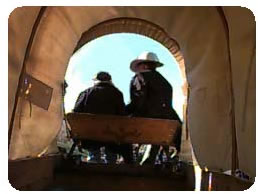Heritage Gateways
Official Sesquicentennial K-12 Education Projectsponsored by the Utah State Board of Education, the BYU-Public School Partnership and the Utah Education Network
Life On The Trail
Problems of Illness, Stress, Privacy, and Traveling

Image courtesy of: Heritage Gateway Project Images, These images have been gathered to support the Sesquicentennial celebration of the immigration to Utah.
Injury, sickness, and death were commonplace. Emigrants suffered cuts; broken bones; gun wounds; burns; scaldings; animal, insect, and snake bites; stampedes; overturned wagons; shifting freight; drownings; quicksand; black scurvy; black canker (probably diphtheria); cholera; typhoid fever; ague; quick consumption (tuberculosis); headaches; piles; mumps; asthma; inflammation of the bowels; scrofula; erysipelas; diarrhea; small pox; itch; and infections of all kinds, including puerperal fever, which can follow childbirth. In reference to the latter, the journals of some of the midwives make melancholy reading. Although oxen moved very slowly, there was no quick way of stopping them. Therefore, many women, because their long skirts got caught, were injured when dragged under animals or wagon wheels. Children often fell under the animals or wagons. Emigrants were also stepped on, gored, and kicked by animals.
Also, because emigrant trains moved so slowly, emigrants, especially children, occasionally got lost. This was the result of straggling, gathering flowers or berries, hunting, attempting short cuts, or trying to visit landmarks that were farther away than they appeared because of the clarity of the high plains' atmosphere. Most found their way back (some were helped by Indians), but some never were seen again in spite of searches, rifle shots, and signal fires.
Some emigrants suffered from being physically or emotionally impaired. There were persons with various kinds of physical disabilities, like blindness, inability to speak, and absence of limbs. Emotional disturbances ranged from the mild to the bizarre. The number of physically and emotionally disabled Mormon emigrants who attempted to cross the plains or whose guardians attempted to take them to Zion is surprising. Mormon emigrant companies probably started out with a higher percentage of disabled people, because of their belief in the "power of the priesthood" and in miracle healing. It was common practice among Mormon emigrants to request church leaders to give blessings to the sick and the injured, and sometimes people were healed. Many were not.
Emigrants were also plagued by mosquitoes, chiggers, ticks, lice, gnats, bed bugs, fleas, flies, and other vermin. To these trials must be added the weaknesses of human beings under stress, which sometimes led to abusive language, fighting, quarreling, divorce, stealing, selfishness, sponging, excessive harshness, and alcohol abuse. Weather was also an important cause of discomfort and death. Emigrants suffered from exposure to heat, mud, wind, rain, cold, snow, and blizzards. Some were hurt and even killed by lightning, and children were occasionally hurt by whirlwinds; one little boy was dropped in the Platte River by one.
Funerals and burials were often hurried affairs, as little time could be spared while en route. Shallow graves were dug, unless the ground was frozen, in which case, no grave could be dug. (In cold but not yet freezing weather, the preferred place to dig a grave was the site of the previous night's campfire.) A few were buried in coffins, many others only in blankets, hollowed out logs, or between pieces of bark. Children were often buried in containers like bread boxes and tea canisters. Some graves were marked, but more often everything was done to obliterate all traces of the grave, to discourage wild animals (and sometimes Indians) from digging up the corpse.
The problem of privacy for the purposes of elimination was solved by following the common rule: men to one side, women to the other. If the women went in a group, several sisters standing with skirts spread wide could provide a privacy screen for each other. Most wagons also had chamber pots.
Source: Historic Resource Study - Mormon Pioneer National By Stanley B. Kimball, Ph.D., May 1991. (The study focuses on the history of the trail from its official beginning in Nauvoo, Illinois, to its terminus in Salt Lake City, Utah, during the period 1846-1869. During that time, thousands of Mormon emigrants used many trails and trail variants to reach Utah. This study emphasizes the 'Pioneer Route' or 'Brigham Young Route' of 1846-1847. The sections on Mormon beliefs and motivations for going west have been omitted. Interested persons can find ample sources for that information. The footnotes, bibliography, maps, pictures, pioneer companies by name and dates for the 22-year period, and historic sites - about 2/3 of the book - have also been left out for space considerations. Thanks to Dr. Kimball and the National Park Service for the availability of this information.)